Astronomy fanatica
-
Swift Gamma-Ray Burst Mission
The Swift Gamma-Ray Burst Mission consists of an unmanned spacecraft called Swift, which was launched into orbit on November 20, 2004, at 17:16:00 UTC (12:16 PM, EST) on top of a Delta 2 rocket. It is managed by NASA's Goddard Space Flight Center.
Computer rendering of the Swift spacecraft (credit NASA).
General Information
Organization: NASA
Wavelength regime: gamma-ray/X-ray/UV/optical
Orbit Height: 600 km
Orbit period: ~90 min
Launch date: 20 November 2004
Deorbit date: ?
Mass: 1,500 kg
Webpage: http://swift.gsfc.nasa.gov/
Physical Characteristics
Telescope Style: coded mask (BAT), Wolter I (XRT), reflector (UVOT)
Diameter: 30 cm (UVOT)
Collecting Area: 5,200 cm² (BAT)
Effective Focal Length: 381 cm (UVOT)
Instruments
BAT: gamma-ray telescope
XRT: X-ray telescope
UVOT: UltraViolet/Optical telescope
Overview
Swift is a multi-wavelength space-based observatory dedicated to the study of gamma-ray burst (GRB) science. Its three instruments will work together to observe GRBs and their afterglows in the gamma-ray, X-ray, ultraviolet, and optical wavebands. This mission is part of NASA's "Medium Explorer program" and the satellite was developed by an international consortium from the United States, United Kingdom, and Italy.
During its nominal mission of two years about 200 GRBs should be observed, and as with many other NASA missions, once the two years are concluded successfully the mission will probably be extended. A dedicated telescope will be used to locate the position of each event with an accuracy of 1 to 4 arc-minutes within 15 seconds. The satellite is then able to reorient itself automatically in about 20 to 75 seconds to point all of its instruments at the burst location. This ability is the reason for the mission's name "Swift." In order to achieve this fast slew rate, the observatory is equipped with momentum wheels as part of its reaction control system. These wheels are more massive than any used on past spacecraft, and are therefore more effective at reorienting the spacecraft when they spin.
In the time between GRB events the instruments on board will conduct an all-sky survey in the hard X-ray. After its successful completion, the survey is anticipated to yield new black hole candidates in the sky.
Instruments
There are three observing instruments on board:
* Burst Alert Telescope (BAT), 15 - 150 keV energy range. It initially detects a new GRB event and computes its coordinates in the sky.
* X-Ray Telescope (XRT), 0.3 - 3 keV energy range. It can take images and perform spectral analyses of the GRB afterglow. This data will provide a more precise location of the GRB and the red-shift of the source.
* UV/Optical Teslescope (UVOT), 170 - 650 nm wavelength range. This instrument will also provide images and spectra. It will be used for follow-up observation of the GRB.
Science goals
This mission has multiple science goals:
* Determine the origin of GRBs. There seem to be at least two types of GRBs, only one of which can be explained with a hypernova, creating a gamma-ray beam. More data is needed to explore other explanations.
* GRBs seem to take place at "cosmological distances," which means they can be used to probe the distant, and therefore young, universe.
* The all-sky survey will be more sensitive than any previous one, and will add significantly to our knowledge of astronomical X-ray sources. Thus, it could also yield unexpected results.
Mission progress
* Swift was launched on November 20, 2004, and reached its design orbit of 584x601 km.
* On December 4 the power up of the on-board devices hit a snag, when the Thermo-Electric Cooler (TEC) for the X-ray CCD did not turn on as expected. Mission members are evaluating in what way the science data will be affected, if the TEC is off for the rest of the mission.
* December 17 at 7:28:30 UT, the Swift Burst Alert Telescope (BAT) triggered and located on-board an apparent gamma-ray burst. The spacecraft did not autonomously slew to the burst since automated slewing was not yet enabled.
* Swift had its first GRB trigger during a period when the automatic slew was allowed on January 17, 2005, at about 12:55 UT. It pointed the XRT telescope to the on-board computed coordinates and observed a bright source in the field of view.
* On February 1, 2005 the mission team released the "first light" picture of the UVOT instrument and declared Swift operational.
* As of April 7, 2005, Swift has detected about two dozen GRBs and X-ray afterglows for about 15 of them, and optical afterglows for a few. Optical afterglows are important for providing distance estimates.
First light image of the Swift UVOT instrument (Credit: NASA/GSFC)
This UVOT image combines both ultraviolet and visible light from a number of filters. Each filter is sensitive to light of a different color, ranging from ultraviolet light beyond the range of human eyesight through the blue to yellow portion of the visible spectrum. This is a 'false-color' image with the shortest wavelength ultraviolet rays being represented as blue, and the longest visible light wavelengths as red. The image shows that hot young stars are being formed in abundance in M101, especially in the spiral arms of the galaxy, where they show up in ultraviolet light. The central regions of the galaxy have more cool, old stars, which appear 'red' in the picture. A number of foreground stars, located in our own Galaxy, also reveal themselves by their red color.
Important events and results
On May 9, 2005, Swift detected the flash of two neutron stars crashing together, a burst of gamma rays that lasted one-twentieth of a second. The craft slewed to look towards the direction of the flash and about 53 seconds after the initial burst, the X-ray telescope caught the rapidly fading afterglow of the event. The detection marks the first time that the location of a short-duration gamma-ray burst has been identified. (Cowen, 2005)
Issue #162 -
Astronomy Picture of the Day
2005 August 11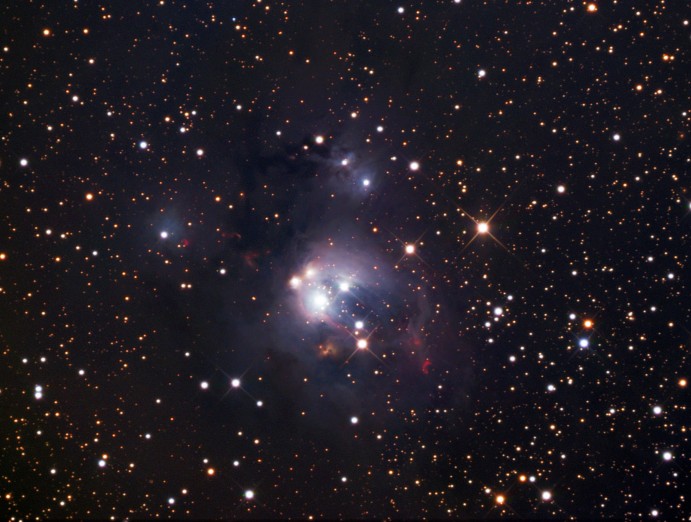
Young Suns of NGC 7129
Explanation: Young suns still lie within dusty NGC 7129, some 3,000 light-years away toward the royal constellation Cepheus. While these stars are at a relatively tender age, only about a million years old, it is likely that our own Sun formed in a similar stellar nursery some five billion years ago. Most noticeable in the striking image are the lovely bluish dust clouds that reflect the youthful starlight, but the smaller, deep red crescent shapes are also markers of energetic, young stellar objects. Known as Herbig-Haro objects, their shape and color is characteristic of glowing hydrogen gas shocked by jets streaming away from newborn stars. Ultimately the natal gas and dust in the region will be dispersed, the stars drifting apart as the loose cluster orbits the center of the Galaxy. NGC 7129 is about 10 light-years across.
Credit & Copyright: Robert Gendler -
Anglo-Australian Telescope
The Anglo-Australian Telescope (AAT) is a 3.9 m equatorially mounted telescope located at Anglo-Australian Observatory (part of the Siding Spring Observatory complex, Australia) at an altitude of a little over 1,100 m. Jointly funded by the United Kingdom and Australia it is used for a number of instruments, perhaps most notably the Two Degree Field facility, or 2dF.
The Anglo-Australian Telescope at Siding Spring Observatory.
The telescope was commissioned in 1974 with a view to allowing high quality observations of the sky from the southern hemisphere, as in the 1970s most major telescopes were located in the north.
The equatorial mount it uses is somewhat unusual, as more recent large telescopes tend to use an altazimuth mount.
Issue #163 -
Hi,
I am into astronomy. I have my own astronomy forum website at http://astro.jconserv.net. If you are interested, you can join along and chat with members from other countries.
Charles -
Astronomy Picture of the Day
2005 August 12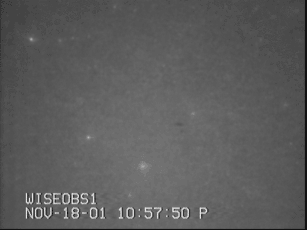
A Perseid Meteor Shower Fireball Movie
Explanation: Go outside tonight and see a celestial light show -- the later the better. Tonight is the peak of the month-long Perseid Meteor Shower. Although visible every year at this time, the Perseids are expected to appear particularly active this year due to the relative absence of glare from the Moon during the peak. Tonight, a thin moon will set a few hours after the Sun, leaving a moonless and dark sky. All through the night, all over the sky, meteors will appear to shoot out the constellation Perseus and across the sky. The rate of meteors and fireballs is not known for sure, but expected by some to be as high as one meteor flash every minute. Lucky sky gazers might be treated to a bright fireball like the one pictured above. That fireball was captured by a digital recorded over Wise Observatory during the 2001 Perseids. The meteor shower poses no danger as few, if any, of the sand-sized flaring bits are expected to reach the ground.
Credit & Copyright: D. Polishook, N. Brosch, & I. Manulis (Tel-Aviv U., Wise Obs.), and Spacegaurd Israel -
Deep Space Network
Deep Space Network (DSN) is an international network of radio antennas that supports interplanetary spacecraft missions, and radio and radar astronomy observations for the exploration of the solar system and the universe. The network also supports selected Earth-orbiting missions. DSN is part of the NASA Jet Propulsion Laboratory (JPL).
Deep Space Network operations center
General information
DSN currently consists of three deep-space communications facilities placed approximately 120 degrees apart around the world at:
- the Goldstone Deep Space Communications Complex outside of Barstow, California, United States;
- a complex in Robledo de Chavela, 60 kilometres (37 miles) west of Madrid, Spain; and
- the Canberra Deep Space Communications Complex (CDSCC) in the Australian Capital Territory, 40 kilometres (25 miles) southwest of Canberra, Australia near the Tidbinbilla Nature Reserve.
Each facility is situated in semi-mountainous, bowl-shaped terrain to shield against radio frequency interference. This strategic placement permits constant observation of spacecraft as the Earth rotates, and helps to make the DSN the largest and most sensitive scientific telecommunications system in the world.
NASA's scientific investigation of the Solar System is being accomplished mainly through the use of unmanned spacecraft. The DSN provides the vital two-way communications link that guides and controls these planetary explorers, and brings back the images and new scientific information they collect. All DSN antennas are steerable, high-gain, parabolic reflector antennas.
The antennas and data delivery systems make it possible to:
- Acquire telemetry data from spacecraft.
- Transmit commands to spacecraft.
- Track spacecraft position and velocity.
- Perform very-long-baseline interferometry observations.
- Measure variations in radio waves for radio science experiments.
- Gather science data.
- Monitor and control the performance of the network.
The network is a facility of the JPL and is managed and operated for NASA by the California Institute of Technology (Caltech). The Interplanetary Network Directorate (IND) manages the program within JPL.
Antennae
Each complex consists of at least four deep space stations equipped with ultrasensitive receiving systems and large parabolic dish antennas. There are:
- One 34-metre (111-foot) diameter High Efficiency antenna.
- One 34-metre Beam Waveguide antenna (Three at the Goldstone Complex and two at the Madrid complex).
- One 26-metre (85-foot) antenna.
- One 70-metre (230-foot) antenna.
70 m antenna at Goldstone
Five new 34-metre beam waveguide antennas were added to the system in the late 1990s. Three were located at Goldstone, and one each in both Canberra and Madrid. A second 34-metre beam waveguide antenna was completed at the Madrid complex in 2004.
The ability to array several antennas was installed to improve the data returned from the Galileo spacecraft. The array electronically links the 70-metre antenna at the Deep Space Network complex in Goldstone, California, with an identical antenna located in Australia, in addition to two 34-metre (111-foot) antennas at the Canberra complex. The California and Australia sites concurrently pick up communications with Galileo.
All the stations are remotely operated from a centralized Signal Processing Center at each complex. The Centers house the electronic subsystems that point and control the antennas, receive and process the telemetry data, transmit commands, and generate the spacecraft navigation data.
Once the data are processed at the complexes, it is transmitted to JPL for further processing and distribution to science teams over a modern ground communications network.
History
The forerunner of the DSN was established in January, 1958, when JPL, then under contract to the U.S. Army, deployed portable radio tracking stations in Nigeria, Singapore, and California to receive telemetry and plot the orbit of the Army-launched Explorer 1, the first successful U.S. satellite. NASA was officially established on October 1, 1958, to consolidate the separately developing space-exploration programs of the Army, Navy, and Air Force into one civilian organization.
On December 3, 1958, JPL was transferred from the Army to NASA and given responsibility for the design and execution of lunar and planetary exploration programs using automatically operated spacecraft. Shortly afterward, NASA established the concept of the Deep Space Network as a separately managed and operated communications facility that would accommodate all deep space missions, thereby avoiding the need for each flight project to acquire and operate its own specialized space communications network. The Deep Space Network was given responsibility for its own research, development, and operation in support of all of its users. Under this concept, it has become a world leader in the development of low-noise receivers, tracking, telemetry and command systems, digital signal processing, and deep space navigation.
Issue #164 -
Astronomy Picture of the Day
2005 August 13
SNR 0103-72.6: Oxygen Supply
Explanation: A supernova explosion, a massive star's inevitable and spectacular demise, blasts back into space debris enriched in the heavy elements forged in its stellar core. Incorporated into future stars and planets, these are the elements ultimately necessary for life. Seen here in a false-color x-ray image, supernova remnant SNR 0103-72.6 is revealed to be just such an expanding debris cloud in neighboring galaxy, the Small Magellanic Cloud. Judging from the measured size of the expanding outer ring of shock-heated gas, about 150 light-years, light from the original supernova explosion would have first reached Earth about 10,000 years ago. Hundreds of supernova remnants have been identified as much sought after astronomical laboratories for studying the cycle of element synthesis and enrichment, but the x-ray data also show that the hot gas at the center of this particular supernova remnant is exceptionally rich in neon and oxygen.
Credit: S.Park, D. Burrows (PSU) et al., Chandra Observatory, NASA -
Astronomy Picture of the Day
2005 August 14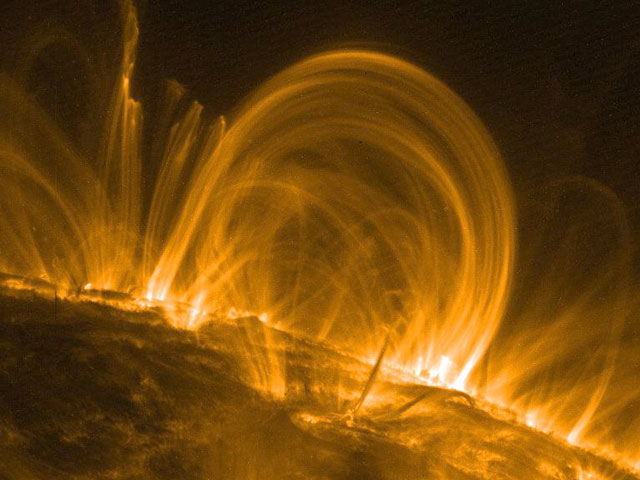
Heating Coronal Loops
Explanation: Why is the corona of the Sun so hot? Extending above the photosphere or visible surface of the Sun, the faint, tenuous solar corona can't be easily seen from Earth, but it is measured to be hundreds of times hotter than the photosphere itself. Astronomers have long sought the source of the corona's heat in magnetic fields which loft monstrous loops of solar plasma above the photosphere. Detailed observations of coronal loops from the orbiting TRACE satellite are pointing more closely to the unidentified energy source. Recorded in extreme ultraviolet light, this and other TRACE images indicate that significant heating occurs low in the corona, near the bases of the loops as they emerge from and return to the solar surface. This tantalizing TRACE image shows clusters of the majestic, hot coronal loops which span 30 or more times the diameter of planet Earth.
Credit: M. Aschwanden et al. (LMSAL), TRACE, NASA -
GALEX
The Galaxy Evolution Explorer (GALEX) is an orbiting space telescope that was launched on April 28, 2003. A Pegasus rocket placed GALEX into a nearly circular orbit at an altitude of 697 km (432 miles) and an inclination to the Earth's equator of 29 degrees.
Galaxy Evolution Explorer (GALEX)
The first observation (called "First Light") was dedicated to the crew of the Space Shuttle Columbia and images the sky in the constellation Hercules, taken on May 21, 2003. This region was selected because it was directly overhead of the shuttle, when it had last contact with NASA Mission Control.
Science mission
During its nominal 29 months mission it makes observations at ultraviolet wavelengths to measure the history of star formation in the Universe 80 percent of the way back to the Big Bang. Since scientists believe the universe is about 13 billion years old, the mission will study galaxies and stars across about 10 billion years of cosmic history.
GALEX at the pre-launch tests. In the Multi-Payload Processing Facility, workers check the deployment of the cover of the telescope on the GALEX satellite. The Galaxy Evolution Explorer (GALEX) is an orbiting space telescope that will observe galaxies in ultraviolet light across 10 billion years of cosmic history. Led by the California Institute of Technology, GALEX will conduct several first-of-a-kind sky surveys, including an extra-galactic (beyond our galaxy) ultraviolet all-sky survey. During its 29-month mission GALEX will produce the first comprehensive map of a Universe of galaxies under construction, bringing more understanding of how galaxies like the Milky Way were formed. GALEX was due to be launched from Cape Canaveral Air Force Station via a Pegasus rocket.
The spacecraft's mission is to observe hundreds of thousands of galaxies, with the goal of determining how far away each galaxy is from Earth and how fast stars are forming (star formation rate, or SFR) in each galaxy. A galaxyÂ’s ultraviolet brightness tells us how fast its stars are forming. Mission scientists will be trying to find stars that have recently formed, so they will be looking for stars whose appearance reveals them to be young. These are the most massive stars, which are so hot they shine in ultraviolet wavelengths.
Scientists would like to understand when the stars that we see today were formed, and when the chemical elements that make up our Milky Way galaxy formed. We know they formed in the interiors of stars, but we don't know when. Information gathered by the mission will fill in one of the missing pieces of the puzzle to explain how the visible universe came to be.
Partnering with JPL on the mission are the California Institute of Technology, Pasadena, Calif.; Orbital Sciences Corporation, Germantown, Md.; University of California, Berkeley; Yonsei University, Seoul, Korea; Johns Hopkins University, Baltimore, Md.; and Laboratoire d'Astrophysique de Marseille, France.
Issue #165 -
Astronomy Picture of the Day
2005 August 15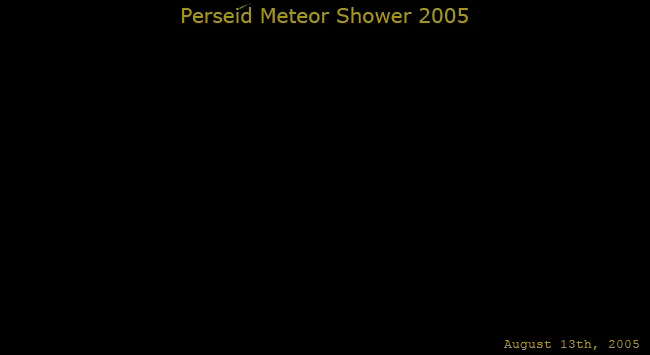
Perseid Meteors and the Milky Way
Explanation: Where will the next Perseid meteor appear? Sky enthusiasts who trekked outside for the Perseid meteor shower that peaked over the past few days typically had this question on their mind. The above movie, where the time-line has been digitally altered, captures part of that very mystery. Eight meteors from the night of August 12 and the morning of August 13 have been identified in the movie so far, seven of which are Perseids. Can you identify the non-Perseid meteor? Since all Perseid meteors appear to come from the constellation of Perseus, the non-Perseid meteor is the one that streaks in a different direction. Early reports are that this year's Perseids were unfortunately a bit disappointing. The above digital mosaic was taken from Alsace, France, with the photogenic band of our Milky Way Galaxy far in the background.
Credit & Copyright: Stefan Seip -
Hipparcos
The High Precision Parallax Collecting Satellite of the Hipparcos Space Astrometry Mission was a project of the European Space Agency (ESA) dedicated to the measurement of stellar parallax and the proper motions of stars. The project was named in honor of Hipparchus. The satellite was used to measure the distances to over 2.5 million stars, within 150 pc of Earth; resulting in the Tycho Catalogue. The Hipparcos plans were proposed in 1980.
Hipparcos
The satellite was launched, by an Ariane 4, on August 18, 1989. The original goal was to place the satellite in a geostationary orbit above the earth, however a booster rocket failure resulted in a highly elliptical orbit from 315 to 22,300 miles altitude. Despite this difficulty, most of the scientific goals were accomplished. Communications were terminated on August 17, 1993.
The program was divided in two parts: the Hipparcos experiment whose goal was to measure the five astrometric parameters of some 120,000 stars to a precision of some 2 to 4 milli-arcsec and the Tycho experiment, whose goal was the measurement of the astrometric and two-colour photometric properties of some 400,000 additional stars to a somewhat lower precision.
The final Hipparcos Catalogue (120,000 stars with 1 milliarcsec level astrometry) and the final Tycho Catalogue (more than one million stars with 20-30 milliarcsec astrometry and two-colour photometry) were completed in August 1996. The catalogues were published by ESA in June 1997.
The Hipparcos and Tycho data have been used to create the Millennium Star Atlas: an all-sky atlas of one million stars to visual magnitude 11, from the Hipparcos and Tycho Catalogues and 10,000 nonstellar objects included to complement the catalogue data.
There were questions over whether Hipparcos has a systematic error of about 1 milliarcsec in at least some parts of the sky. The value determined by Hipparcos for the distance to the Pleiades is about 10% less than the value obtained by some other methods. By early 2004, the controversy remained unresolved. In June 2004, Hubble multi-year parallax observations confirmed Palomar interferometer measurements that the Hipparcos distance was some 10% too small.
Issue #166 -
Astronomy Picture of the Day
2005 August 16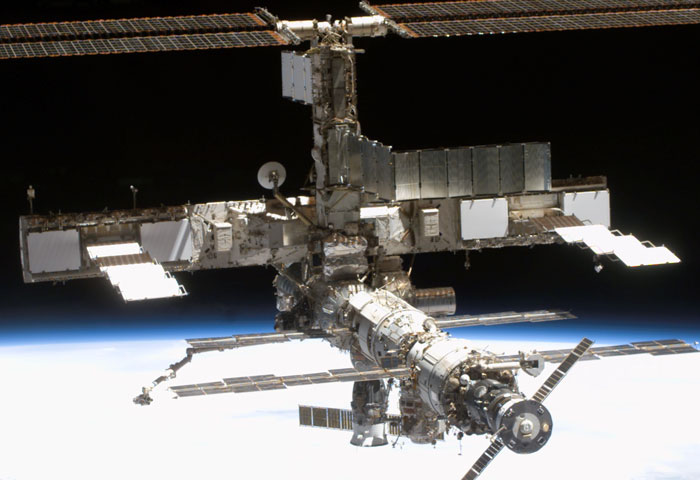
The International Space Station from Orbit
Explanation: The International Space Station (ISS) is the largest human-made object ever to orbit the Earth. Late last month and earlier this month, the station was visited and resupplied by space shuttle Discovery. The ISS is currently operated by the Expedition 11 crew, consisting a Russian and an American astronaut. After departing the ISS, the crew of Discovery captured this spectacular vista of the orbiting space city. Visible components include modules, trusses, and expansive solar arrays that gather sunlight that is turned into needed electricity.
Credit: STS-114 Crew, NASA -
Isaac Newton Telescope
The Isaac Newton Telescope or INT is a 2.5 m optical telescope run by the ING at Roque de los Muchachos Observatory on La Palma in the Canary Islands. It was originally situated at Herstmonceux Castle in Sussex, England, which was the site of the Royal Greenwich Observatory after it moved away from Greenwich due to light pollution. It was inaugurated in 1967 by Elizabeth II. The telescope is now one member of the Isaac Newton Group of Telescopes.
The Isaac Newton Telescope (INT) dome by moonlight
However, Herstmonceux suffered from poor weather, and the advent of mass air travel made it plausible for UK astronomers to run an overseas observatory. In 1979, the INT was shipped to La Palma, where it has remained ever since. The move was beset with difficulties, and it is widely recognised that it would have been cheaper to have built a new telescope rather than moving an existing one. As is customary for astronomical telescopes, the telescope foundations were entirely separate from the foundations of the dome and the rest of the structure in order to minimise telescope vibrations from movements of the dome (with an air gap of a few centimeters inbetween, going down many meters below the telescope platform). When the local construction workers on La Palma saw this air gap, they filled it with concrete under the assumption that this would be helpful (in making it stronger). It was impossible to remove this concrete, and it has been very difficult to keep telescope vibrations at a bearable level as a result.
Today, it is used mostly with the Wide Field Camera (WFC), a four CCD instrument with a field of view of 0.5 square degrees which was commissioned in 1997. The other main instrument available at the INT in earlier times was the Intermediate Dispersion Spectrograph (IDS).
Technical details
The INT is a Cassegrain telescope, with a 2.54 m diameter primary mirror and a focal length of 7.5 m. The mirror weighs 4,361 kg, and is supported by a polar disc/fork type equatorial mounting. The total weight of the telescope is around 90 tonnes. The f/3.29 Prime focus, used with the WFC, allows an unvignetted field of view of 40 arcminutes (approximately 0.5 square degrees). There is also a secondary focal station, the f/15 Cassegrain focus, which possesses a 20 arcminute field of view and was the mount point for the IDS.
The pointing accuracy of the telescope is around 5 arcseconds, but a sophisticated autoguider, which tracks a given guide star and makes small corrections to the telescope tracking, allows a guiding accuracy of better than 0.3 arcseconds.
Issue #167 -
Astronomy Picture of the Day
2005 August 17
Planets over Paranal
Explanation: Very bright planets and very large telescopes are part of this sunset view of Paranal Observatory. The observatory's four, massive 8.2 meter telescope units are situated on top of the 2,600 meter high mountain, Cerro Paranal, in the dry Atacama Desert in northern Chile. The individual unit telescopes can be used separately or in combination and are named Antu, Kueyen, Melipal, and Yepun. Together they are fittingly known as the European Southern Observatory's Very Large Telescope. Of course, the very bright planets are Venus (near center), joined by Mercury (below) and Saturn (left) in late June's western evening skies.
Credit & Copyright: Stephane Guisard -
La Silla Observatory
La Silla Observatory is an astronomical observatory in Chile with eighteen telescopes. Five of these telescopes were built by the European Southern Observatory (ESO) organisation, and several of the others are partly maintained by ESO. The observatory is one of the largest in the Southern Hemisphere.
La Silla Observatory
La Silla is a 2,400-m mountain, bordering the southern extremity of the Atacama desert in Chile. It is located about 160 Km north of La Serena. Its geographical coordinates are: Latitude 29º 15' south & Longitude 70º 44' west.
Originally known as Cinchado, the mountain was renamed La Silla (the saddle) after its shape. It rises quite isolated and remote from any artificial light and dust sources (astronomy's worst enemies). La Silla was the observatory in Chile used by ESO. Its history is full of optimism and disappointments, ups and downs, since its beginnings in the 50's until the middle of the 70's when the observatory became a reality.
Telescopes at La Silla Observatory
NTT (3.5 m) - Built and operated by ESO
3.6 m - Built and operated by ESO
2.2 m - On loan from MPG
ESO 1.5 m - Built by ESO, now decommisioned
ESO 1 m - Built by ESO, now decommisioned
ESO 0.5 m - Built by ESO, now decommisioned
DENIS 1 m
MARLY 1 m (EROS project)
Geneva 1.2 m
Danish 1.5 m
Danish 50 cm
Dutch 90 cm
SEST 15 m
Marseille 40 cm
Bochum 61 cm
CAT 1.4 m
IRIS
Schmidt 1 m
GPO (replaced by Marly 1 m)
This view above the ESO La Silla Observatory in the southernmost part of the Atacama desert was obtained some evenings ago by ESO Software Engineer Nico Housen. Normally stationed at the Paranal Observatory, he seized the opportunity of a visit to ESO's other observatory site to produce this amazing vista of the early evening scenery.
To the left is the decommisioned 15-metre dish of the Swedish-ESO Submillimetre Telescope (SEST), and on the right in the background is the dome of the ESO 3.6-metre telescope, at the highest point of the mountain. The southern Milky Way is seen along the right border of the SEST and above the 3.6 metre telescope. There is an upside-down reflection of the sky and the horizon behind the photographer in the highly polished antenna dish of the SEST. Besides the reflection of the horizon (the darker part in the top of the dish) and the Milky Way (which runs as a thin cloud from the bottom of the dish up to the horizon) there is also a yellow area of light to the right. This is the reflection of the city lights of the city of La Serena, about 100 km away and too faint to disturb observations of celestial objects high above La Silla.
The 3.6-m telescope began operations in 1976 and was ESO's largest telescope until the advent of the VLT at Paranal. Never endowed with a fancy name like the VLT Unit telescopes, the "3.6-m" houses several state-of-the-art astronomical instruments, including the ultra-precise HARPS facility that is used to hunt for exoplanets, cf. ESO PR 22/04.
The SEST was for a long time the only instrument of its kind in the southern hemisphere. With it, ESO gained invaluable experience in ground-based non-optical observations, paving the way for the ALMA project.
The Atacama Large Millimetre Array (ALMA) [1] is one of the largest ground-based astronomy projects of the next decade after the ESO VLT. Its construction started last year and will be completed by 2011. When ready, it will be the largest and most sensitive astronomical observatory of its kind, comprisiing some sixty-four 12-m antennas located on a 10-km wide plateau at a 5,000-m elevation in the Atacama Desert.
Issue #168 -
Astronomy Picture of the Day
2005 August 18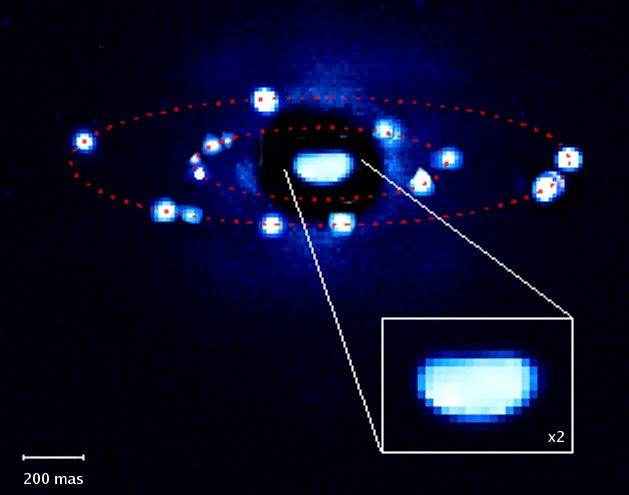
Sylvia, Romulus and Remus
Explanation: Discovered in 1866, main belt asteroid 87 Sylvia lies 3.5 AU from the Sun, between the orbits of Mars and Jupiter. Also shown in recent years to be one in a growing list of double asteroids, new observations during August and October 2004 made at the Paranal Observatory convincingly demonstrate that 87 Sylvia in fact has two moonlets - the first known triple asteroid system. At the center of this composite of the image data, potato-shaped 87 Sylvia itself is about 380 kilometers wide. The data show inner moon, Remus, orbiting Sylvia at a distance of about 710 kilometers once every 33 hours, while outer moon Romulus orbits at 1,360 kilometers in 87.6 hours. Tiny Remus and Romulus are 7 and 18 kilometers across respectively. Because 87 Sylvia was named after Rhea Silvia, the mythical mother of the founders of Rome, the discoverers proposed Romulus and Remus as fitting names for the two moonlets. The triple system is thought to be the not uncommon result of collisions producing low density, rubble pile asteroids that are loose aggregations of debris.
Credit: F. Marchis (UC Berkeley) and P. Descamps, D. Hestroffer, J. Berthier (Obs. de Paris), ESO -
Astronomy Picture of the Day
2005 August 19
NGC 1 and NGC 2
Explanation: Beautiful nebulae, clusters, and galaxies that grace planet Earth's night sky are often known by their New General Catalog designation or NGC number. That classic listing was compiled by John Louis Emil Dreyer, remarkable director of the Armagh Observatory from 1882 to 1916. NGC 2266 is, for example, the 2,266th item in his New General Catalog of Nebulae and Clusters of Stars. Noting that "every book has a first page", modern day astronomer Jay GaBany wondered what NGC 1 might look like - and found it, along with NGC 2 in the constellation Perseus. Pictured above, both are more or less typical-sized (50-100 thousand light-years across) spiral galaxies with estimated distances of over 150 million light-years for NGC 1 (top) and about twice that for NGC 2. NGC ordering is based on an astronomical coordinate system, so these otherwise unremarkable spirals appear first in the NGC listing because their location in the sky translates to the smallest Right Ascension coordinate in the catalog.
Credit & Copyright: R Jay GaBany (Cosmotography.com) -
MAGIC
MAGIC is the Major Atmospheric Gamma-ray Imaging Cherenkov Telescope. It is sited at Roque de los Muchachos Observatory on La Palma in the Canary Islands. With a large mirrored dish 17 m across and with an area of 240 square metres, it is able to detect the flashes of light induced in the atmosphere by cosmic rays and is intended in particular to detect gamma rays.
It began producing data in 2004 and is a followup to the HEGRA experiment.
The 17 m diameter MAGIC Telescope on the Canary Island of La Palma.
Collaborating Institutions
- Institut de FÃsica d'Altes Energies, University of Barcelona
- Universitat Autònoma de Barcelona
- Institut für Physik, Humboldt-University of Berlin
- Crimean Astrophysical Observatory
- University of California, Davis, USA
- Universidad Complutense, Madrid
- Division of Experimental Physics, University of Lodz
- Max-Planck-Institute for Physics, Munich
- Physics Department, Università di Padova and INFN sez. di Padova, Italy
- Space Research Unit, Potchefstroom University
- Dipartimento di Fisica, Università di Siena and INFN sez. di Pisa, Italy
- Institute for Nuclear Research and Nuclear Energy, Sofia
- Tuorla Observatory, Pikkiö, Finland
- Dipartimento di Fisica dell'Università di Udine and INFN sez. di Trieste, Italy
- University of Würzburg
- Yerevan Physics Institute, Cosmic Ray Division, Jerewan
- Institute for Particle Physics, Eidgenössische Technische Hochschule Zürich
During foggy nights, the laser reference beams of MAGIC's active control can be seen.
Issue #169 -
Astronomy Picture of the Day
2005 August 20
The Stars of NGC 300
Explanation: Like grains of sand on a cosmic beach, individual stars of large spiral galaxy NGC 300 are resolved in this sharp image from the Hubble Space Telescope's Advanced Camera for Surveys (ACS). The inner region of the galaxy is pictured, spanning about 7,500 light-years. At its center is the bright, densely packed galactic core surrounded by a loose array of dark dust lanes mixed with the stars in the galactic plane. NGC 300 lies 6.5 million light-years away and is part of a group of galaxies named for the southern constellation Sculptor. Hubble's unique ability to distinguish so many stars in NGC 300 can be used to hone techniques for making distance measurements on extragalactic scales.
Credit: Hubble Heritage Team (AURA / STScI), ESA, NASA -
XMM-Newton
The XMM-Newton is a X-ray observatory satellite. It is named in honour of Isaac Newton; XMM stands for X-ray Multi-Mirror.
Officially known as the High Throughput X-ray Spectroscopy Mission, it was launched by the European Space Agency from Kourou on December 10, 1999 by an Ariane 5 rocket. It was placed in a very eccentric 48 hour elliptical orbit at 40°; at its apogee it is nearly 114,000 km from Earth, while the perigee is only 7,000 km.
XMM-Newton satellite
The satellite weighs 3,800 kg, is 10 m long and 16 m in span with its solar arrays deployed. It holds three X-ray telescopes, developed by Media Lario of Italy, each of which contains 58 wolter-type concentric mirrors. The telescopes cover a range of 12 keV to 0.1 keV and have a combined collecting surface of 4,300 cm². Other instruments onboard are three photon imaging cameras, two reflection grating spectrometers and a 30 cm Ritchey-Chretien optical monitor.
The mission was proposed in 1984 and approved in 1985; a project team was formed in 1993 and development work began in 1996. The satellite was constructed and tested from March 1997 to September 1999. It has a mission lifetime of two years, with a possible extension of up to eight years for further observations. These observations are managed from VILSPA at Villafranca, Spain and the information is processed and archived at the XMM-Newton Survey Science Centre at Leicester University, England.
XMM-Newton observed the comet 9P/Tempel 1 during the impact caused by Deep Impact.
Issue #170 -
Astronomy Picture of the Day
2005 August 21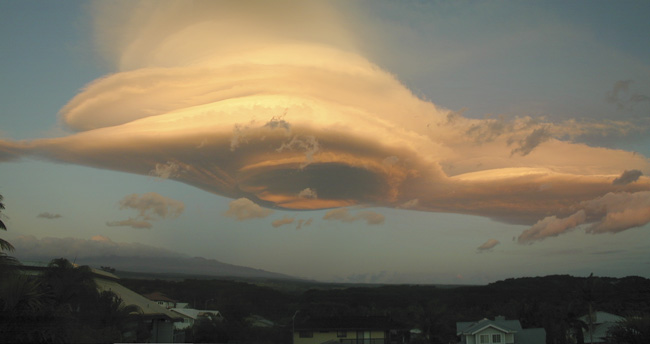
A Lenticular Cloud Over Hawai'i
Explanation: Can a cloud do that? Actually, pictured above are several clouds all stacked up into one striking lenticular cloud. Normally, air moves much more horizontally than it does vertically. Sometimes, however, such as when wind comes off of a mountain or a hill, relatively strong vertical oscillations take place as the air stabilizes. The dry air at the top of an oscillation may be quite stratified in moisture content, and hence forms clouds at each layer where the air saturates with moisture. The result can be a lenticular cloud with a strongly layered appearance. The above picture was taken last week near Mauna Kea, Hawaii, USA.
Credit & Copyright: Peter Michaud (Gemini Obs.) -
Astronomy Picture of the Day
2005 August 22
Desolate Mars: Rub al Khali
Click above link for picture.
Explanation: Sometimes on Mars, there is nothing to see but red sand. Traveling two kilometers south of Endurance Crater, the robotic rover Opportunity now exploring Mars stopped and took a 360 degree panorama of a desolate and rusted Martian landscape. The site was dubbed Rub al Khali for its similarity to a barren part of the Saudi Arabian desert on Earth. In the center of the frame, the tracks from the rover's grated wheels can be seen receding far into the distance. Near the bottom, several parts of Opportunity itself are recorded, including, on the far right, a Martian sundial. Nearly 100 images in three colors to generate the above spectacular real-color image mosaic. To display the full high-resolution image would require about 300 computer monitors -- or one good large format printer.
Credit: Mars Exploration Rover Mission, JPL, NASA -
Canada-France-Hawaii Telescope
The Canada-France-Hawaii Telescope (CFHT) is located near the mountain top of Mauna Kea in Hawaii at an altitude of 4,204 m (13,793 feet). It is a Prime Focus/Cassegrain configuration with a usable aperture diameter of 3.58 meters.
The Canada-France-Hawaii Telescope in the morning.
Asteroid Eugenia and its moon, Petit-Prince, imaged by the Canada-France-Hawaii telescope. This is a time-lapse image, showing five stages in the moon's orbit around Eugenia taken in in November 1998. The 'flares' are optical artifacts.
Issue #171 -
Astronomy Picture of the Day
2005 August 23
NGC 281: The Pacman Nebula
Explanation: NGC 281 is a busy workshop of star formation. Prominent features include a small open cluster of stars, a diffuse red-glowing emission nebula, large lanes of obscuring gas and dust, and dense knots of dust and gas in which stars may still be forming. The open cluster of stars IC 1590 visible around the center has formed only in the last few million years. The brightest member of this cluster is actually a multiple-star system shining light that helps ionize the nebula's gas, causing the red glow visible throughout. The lanes of dust visible left of center are likely homes of future star formation. Particularly striking in the above photograph are the dark Bok globules visible against the bright nebula. The NGC 281 system, dubbed the Pacman nebula for its overall shape, lies about 10 thousand light years distant.
Credit & Copyright: Steve Cannistra (StarryWonders) -
Dutch Open Telescope
The Dutch Open Telescope (DOT) is an innovative new optical solar telescope at the Roque de los Muchachos Observatory on La Palma (near the Swedish Solar Telescope). The DOT provides extended sequences of solar images in various wavelengths with high angular resolution (0.2 arcsec).
Dutch Open Telescope
Official website
Issue #172